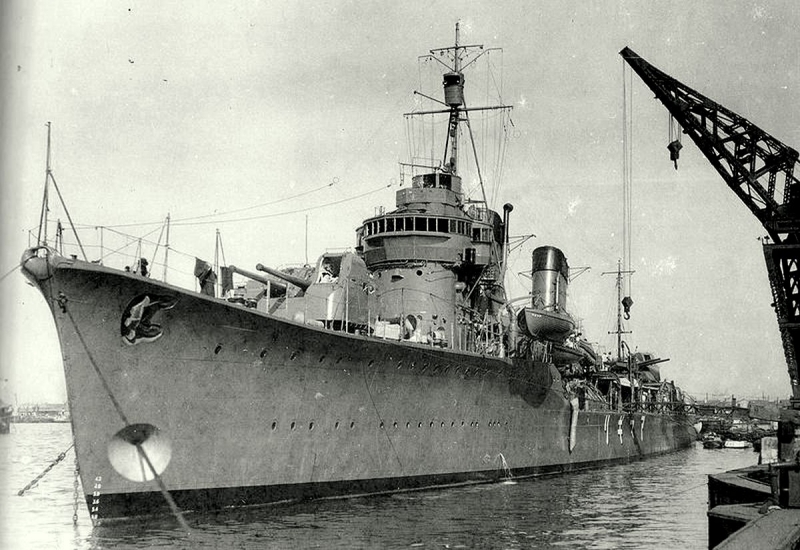| Precedente Successiva |
 |
| Amagiri |
| History Empire of Japan Name: Amagiri Ordered: 1923 Fiscal Year Builder: Ishikawajima Shipyards Yard number: Destroyer No. 49 Laid down: 28 November 1928 Launched: 27 February 1930 Commissioned: 10 November 1930 Fate: Sunk near Borneo, 23 April 1944 General characteristics Class & type: Fubuki-class destroyer Displacement: ? 1,750 long tons (1,780 t) standard ? 2,050 long tons (2,080 t) re-built Length: ? 111.96 m (367.3 ft) pp ? 115.3 m (378 ft) waterline ? 118.41 m (388.5 ft) overall Beam: 10.4 m (34 ft 1 in) Draft: 3.2 m (10 ft 6 in) Propulsion: ? 4 ? Kampon type boilers ? 2 ? Kampon Type Ro geared turbines ? 2 ? shafts at 50,000 ihp (37,000 kW) Speed: 38 knots (44 mph; 70 km/h) Range: 5,000 nmi (9,300 km) at 14 knots (26 km/h) Complement: 219 Armament: ? 6 ? Type 3 127 mm 50 caliber naval guns (3?2) ? up to 22 ? Type 96 25 mm AT/AA Guns ? up to 10 ? 13 mm AA guns ? 9 ? 610 mm (24 in) torpedo tubes ? 36 ? depth charges Service record Operations: ? Second Sino-Japanese War ? Battle of Malaya ? Battle of Midway ? Indian Ocean raid ? Solomon Islands campaign Amagiri (天霧 "Heavenly Mist"?) was the 15th of 24 Fubuki-class destroyers, built for the Imperial Japanese Navy following World War I. When introduced into service, these ships were the most powerful destroyers in the world. They served as first-line destroyers through the 1930s, and remained formidable weapons systems well into the Pacific War. She is most famous for ramming the PT-109 commanded by Lieutenant John F. Kennedy, who would later become the 35th President of the United States. History Construction of the advanced Fubuki-class destroyers was authorized as part of the Imperial Japanese Navy's expansion program from fiscal 1923, intended to give Japan a qualitative edge with the world's most modern ships.[3] The Fubuki class had performance that was a quantum leap over previous destroyer designs, so much so that they were designated Special Type destroyers (特型 Tokugata?). The large size, powerful engines, high speed, large radius of action and unprecedented armament gave these destroyers the firepower similar to many light cruisers in other navies.[4] Amagiri, built at the Ishikawajima Shipyards in Tokyo was the fifth in an improved series, which incorporated a modified gun turret which could elevate her main battery of 127 mm (5.0 in)/50 cal Type 3 naval guns to 75? as opposed to the original 40?, thus permitting the guns to be used as dual purpose guns against aircraft. Amagiri was laid down on 28 November 1928, launched on 27 February 1930 and commissioned on 10 November 1930. Originally assigned hull designation ?Destroyer No. 49?, she was designated Amagiri before her launch. Inter-war period In 1935, after the Fourth Fleet Incident, in which a large number of ships were damaged by a typhoon, Amagiri, along with her sister ships, were modified with stronger hulls and increased displacement. In 1937, Amagiri covered landing of Japanese forces in Shanghai and Hangzhou during the Second Sino-Japanese War. In 1940, she was assigned to patrol and cover landings of Japanese forces in south China, and subsequently participated in the Invasion of French Indochina. World War II Early operations At the time of the attack on Pearl Harbor, Amagiri was assigned to Destroyer Division 20 of Desron 3 of the IJN 1st Fleet, and had deployed from Kure Naval District to the port of Samah on Hainan Island. From 4 December 1941, to the end of the year, Amagiri covered the landings of Japanese troops in Malaya, and was part of the escort in support of "Operation L" (the invasion of Banka and Palembang in the Netherlands East Indies. At the end of February, Amagiri covered minesweeping operations around Singapore and Johore. In March, Amagiri was assigned to "Operation T" (the invasion of northern Sumatra) and "Operation D" (the invasion of the Andaman Islands). During the Indian Ocean raids, Amagiri ? together with the heavy cruisers Mogami and Mikuma sank the British passenger ship Dardanus, Steamship Gandara and Merchant ship Indora. From 13?22 April, Amagiri returned via Singapore and Camranh Bay to Kure Naval Arsenal, for maintenance. On 4?5 June, Amagiri participated in the Battle of Midway as was part of the Aleutian Invasion force and was subsequently based at Amami-Ōshima for patrols of southern waters until mid-July. In July 1942, Amagiri sailed from Amami-Ōshima to Mako Guard District, Singapore, Sabang and Mergui for a projected second Indian Ocean raid. The operation was cancelled due to the Guadalcanal campaign, and Amagiri was ordered to Truk instead, arriving in late August. After the Battle of the Eastern Solomons on 24 August, Amagiri took on troops from transport ships while at sea, and sailed on to Guadalcanal. During this operation, she was attacked 60 nmi (110 km; 69 mi) north-northeast of Savo Island by United States Marine Corps SBD Dauntless dive bombers from Henderson Field, which sank her sister ship Asagiri and severely damaged Shirakumo. After rescuing the Asagiri survivors, she towed Shirakumo to Shortlands. Amagiri continued to be used on numerous "Tokyo Express" transport missions to various locations in the Solomon Islands in September.[11] Although reassigned to the IJN 8th Fleet in October, Amagiri continued to be used for "Tokyo Express" missions through the end of the year. After the Naval Battle of Guadalcanal from 13?15 November, she assisted destroyer Mochizuki in the rescue of 1,500 survivors of the merchant vessels Canberra Maru and Nagara Maru, and escorted the damaged Sado Maru to the Shortlands. She returned to Kure Naval Arsenal for repairs by mid-January 1943. Amagiri returned to Rabaul by March 1943, and resumed its missions as a high speed transport. On 7 April, she was strafed by a USAAF B-17 Flying Fortress bomber, killing 10 crewmen. On 5?6 July, during the Battle of Kula Gulf Amagiri was engaged by United States Navy destroyers and cruisers while attempting a troop transport mission to Kolombangara. She took five shell hits, which killed 10 crewmen. After the battle she attempted to rescue the survivors of the destroyer Niizuki, but was driven off by the American destroyers USS Nicholas and Radford and returned to Rabaul for repairs. John F. Kennedy and PT-109 On 2 August, while returning from another "Tokyo Express" night reinforcement fast transport mission to Vila, Amagiri rammed and sank the PT-109 torpedo boat, commanded by the future U.S. President, then Lieutenant, junior grade John F. Kennedy. It is widely believed that those aboard Amagiri were not even aware of PT-109, which was difficult to see because of its small size and lack of lights. However, Robert J. Donovan in his book PT 109: John F. Kennedy in WWII, after interviewing many of the crew, concludes that it was not an accident, and he talked to the man at the wheel who was ordered to steer for a collision course. Amagiri also engaged other PT boats in the Blackett Strait south of Kolombangara. Lieutenant Commander Kohei Hanami ? who commanded Amagiri at that time ? attended President Kennedy's inauguration in 1961. This incident would be publicized in a book, movie, and a hit song as "the Jap destroyer in the night, cut the 109 in two", making it probably the only Japanese ship to ever be mentioned in the top ten of the American Top 40 charts. Subsequent career Amagiri continued to be used on "Tokyo Express" missions through the end of 1943. She engaged United States Navy destroyers in combat at the Battle of Cape St. George in late November, and escaped pursuing American destroyers led by Captain Arleigh Burke. On 7 December, she collided near Kavieng with the destroyer Akikaze, which sheared off her bow. Sent back to Kure Naval Arsenal for repairs in January 1944, she was reassigned to the Southwest Area Fleet in March and was based in Singapore to provide escort for transport missions in the western Netherlands East Indies. On 23 April, after departing Singapore with heavy cruiser Aoba and light cruiser Ōi bound for Davao, Amagiri struck a naval mine in Makassar Strait 55 nmi (102 km; 63 mi) south of Balikpapan at position (02?10′S 116?45′E Coordinates: 02?10′S 116?45′E). As she took over two hours to sink, there were few casualties. Amagiri was struck from the Navy List on 10 June 1944. |
| Username | |
| Armatore | Imperial Japanese Navy |
| Ship manager | |
| Numero IMO | |
| Classificazione | Destroyer |
| Cantiere e anno di costruzione | 1930 Ishikawajima Shipyards |
| Data | |
| Luogo | |
| Aggiunta il | 26/01/2016 |
| Dimensioni | 1200 x 824 |
| visite | 2066 |
















